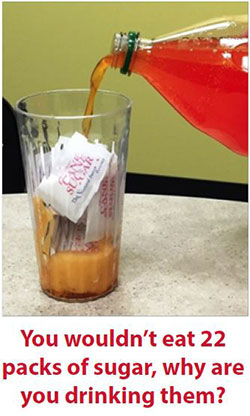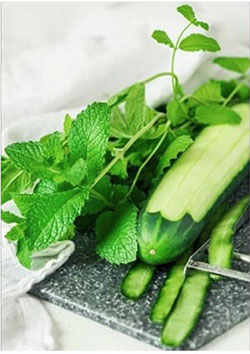Switch from Sugary Drinks – Rethink Your Beverage of Choice
Anne Zander, Family & Consumer Science Agent, Boulder County

One of the earliest references to sugar is a Spanish drawing of a man harvesting honey, dated 7000 B.C. Sugars are widespread in nature and are the building block of carbohydrates. Sugar is naturally found in many foods, including milk, grains, fruits, and vegetables. The sugar found in these foods provides an important fuel source.
Sugar is also added to many foods, such as breads, baked goods, cereals, flavored yogurt, sweetened beverages, and sauces. High consumption of added sugars has been linked to obesity, diabetes, heart disease, tooth decay and gout, so we need to consume them in moderation. Sugary drinks that have become a part of our family traditions provide little or no nutritional value. A family get-togethers we offer sugary drinks without thinking!
One sugary drink per day, per week equals 25% increased risk for type 2 diabetes, 33% higher risk of dying from heart disease, and 55% increased risk of children becoming overweight or obese.
6 oz. Fruit Juice Drink = 4 tsp. sugar
12 oz. Soda = 10 tsp. sugar
20 oz. Sports Drink = 8 tsp. sugar
64 oz. Super-sized Soda = 53 tsp. sugar. Which is more than 1 cup of sugar!
We dare your family to take a 30 day challenge to decrease the amount of sugary beverages they drink by one drink a day, substituting it with water! Water should be the beverage that children (over age 2) consume most frequently.
- Serve water or low fat milk with meals and snacks
- Pack a bottle of ice water
- For variety, try adding pieces of fresh fruit, vegetables, or fresh herbs to water, creating a delicious alternative. (orange wedges, strawberries, cucumber slices, fresh mint, or a bit of seltzer water)
- Add ice or dilute 100% juice with water to cut down on the sweetness.
- Try unsweetened sparkling and mineral waters
- Read labels to check the ingredients listed making sure that there is no added sugars (other names for added sugars: sucrose, glucose, corn syrup, high-fructose corn syrup, fructose and maple syrup)
- Points to keep in mind:
- Avoid flavored milk, which may contain 13 grams or more of added sugar (almost the entire amount of added sugar that a 4-8 year-old child should have in a day!)
- Choose 100% “juice” in moderation (no added sweeteners).
- Children less than 2 two years old should not consume any juice, and other age children should limit their intake to a 4 ounce serving per day. Adults should limit juice to 8 ounces per day.
- Never serve juice or sugary beverages in baby bottles or sippy cups.
- Beware of health claims on “drinks” such as 100% DV vitamin C – “drinks” can be easily fortified and may not be 100% “juice”.
- Children naturally develop a taste for sweet foods and beverages so it is best to introduce juice and other sugary drinks as late as possible.
Let’s Talk
Explain to children that eating and drinking too much sugar is not healthy for their body. Show them how much sugar is in the beverages they usually drink. Ask children to help you decrease the amount of sugary beverages the family drinks. Teach children how to stay healthy. Children can do positive things with the right guidance, support and parental examples, which are very powerful influencers.
These tips that can help you help your family make the switch to healthier drinks.
- It’s ok to start slow. Choose one drink a day to switch to a non-sweetened choice.
- Let your kids pick out a water bottle they like, fill it up, and bring it with them wherever you go.
- Tell other parents that you’re switching to healthy drinks and ask them to serve only water or milk to your child.
- Try limiting the time of day for sugary drinks – like no sugary drinks after lunch.
- Keep up the good work. It’s hard to say no to a child who wants a sugary drink. You’re making a great choice for their health!
| Note: If the container has more than one serving, multiply the number of teaspoons by the number of servings to get the total teaspoons of sugar in the container. For example, 10 teaspoons x 2 servings = 20 total teaspoons. |
Let’s Do the Math Activity – Calculating How Much Sugar Is In a Container
Grams of Sugar ÷ 4 = Teaspoons of Sugar
69 Grams of Sugar ÷ 4 = 17 Teaspoons of Sugar
Example Nutrition Facts Panel
Serving Size 20 fl. oz. (591ml)
Servings per Container 1
Amount per Serving
Calories 250
% Daily Value*
Total Fat 0 g 0%
Sodium 55 mg 2%
Total Carbohydrate 68 g 23%
Sugars 69 g
Protein 0 g 0%

Recipe for Health:
Cucumber Mint Breeze
Ingredients:
½ cup sliced cucumbers
1-2 springs of fresh mint
Water and ice
Directions:
ill a pitcher halfway with ice. Add sliced cucumbers and mint. Fill with water. Chill for at least 20 minutes before serving. Store in refrigerator and drink within 24 hours.
References: CSU Extension Sugar and Sweeteners 9.301; Clemson University Cooperative Extension HGIC 4053; Rudd Center for Food Policy & Obesity; California Dept. of Public Health





